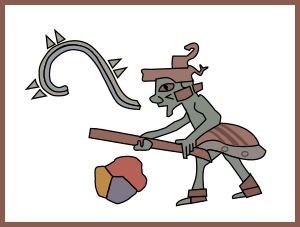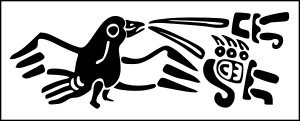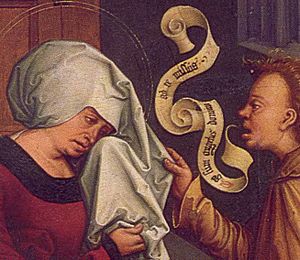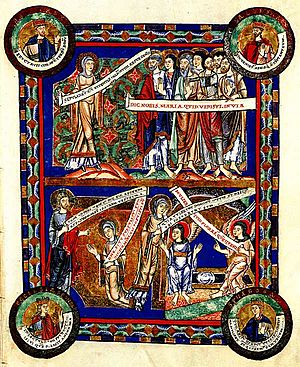Speech scroll facts for kids

Have you ever seen a cartoon character with a bubble coming out of their mouth that shows what they are saying? In ancient art, artists used something similar called a speech scroll. It's a special drawing that shows when someone is speaking, singing, or making other sounds. You might also hear it called a banderole or phylactery.
This cool artistic trick was invented separately in different parts of the world. Artists in Mesoamerica (places like Mexico and Central America) used them from about 650 BC until after the Spanish conquest in the 1500s. European artists also used them during the Medieval and Renaissance periods.
While European speech scrolls looked like actual paper scrolls unrolling, Mesoamerican speech scrolls were shaped more like a question mark.
Speech Scrolls in Ancient Mesoamerica
Speech scrolls are found all over ancient Mesoamerica. One of the oldest examples was found on an Olmec ceramic cylinder seal from around 650 BC. In this image, two lines come out of a bird's mouth, followed by symbols that might mean "3 Ajaw", which was a ruler's name.
The wall paintings at the ancient city of Teotihuacan are full of speech scrolls. For example, a famous painting in the Tepantitla area shows more than 20 speech scrolls!
In Mesoamerica, the speech scroll usually points upwards with its longest edge. The middle part, or "tongue," curves downwards like a spiral. Some Mesoamerican speech scrolls are even divided into two parts, with each side a different color.
Symbols or other marks are rarely seen on Mesoamerican speech scrolls. However, sometimes you can see small, triangular or square shapes called "tabs" along the outer edge. If the speech scroll is like a tongue, maybe these tabs are like teeth. We don't know their exact meaning.
Sometimes, speech scrolls were decorated to show how someone was speaking:
- At the Maya site of Chichen Itza, a ruler's speech scroll looks like a snake. This might show powerful or wise words.
- In an Aztec codex (an ancient book) from the 1500s, a Spaniard's speech scroll has feathers. This meant he was speaking "soft, smooth words."
- In another book from the 1500s, the Selden Codex, two Mixtec rulers are shown insulting two visitors. Their speech scrolls have "flint knife" symbols attached, showing they were saying harsh things.
After the Spanish Conquest, people started writing indigenous languages using the Latin alphabet. Many new codex books were created during this time, like the Codex Quinatzin. This book combines old speech scrolls with actual written words.
European Banderoles
In Europe, speech scrolls are called banderoles. Unlike the abstract shapes in Mesoamerica, European banderoles look like real scrolls floating in space. They became common around the start of the Gothic period. Before this, words were usually just painted next to a person, called tituli.
Some early examples of banderoles include the Aachen Gospels (around 975 AD) and the 12th-century English Romanesque Cloisters Cross. This cross shows banderoles used to identify Old Testament prophets. This helped tell them apart from the Four Evangelists of the New Testament and other Christian saints, who usually carried books. This idea became popular in Italy in the 1200s. It made sense because the Old Testament was originally written on scrolls, while most New Testament writings are codices (like modern books).
Banderoles were also used for the words of angels, especially when the angel Gabriel greeted Mary in Annunciation scenes. By the 1300s, artists used banderoles with quotes to add more complex ideas to their art. However, these quotes were usually in Latin, so not everyone could understand them.
Unlike Mesoamerican speech scrolls, European banderoles usually contain the actual words spoken, much like a modern speech balloon. Most of these are in religious artworks and show quotes from the Bible, often from the person shown. For example, Old Testament prophets were often shown with a quote from their writings. Because the words were often religious, the speech scroll was usually written in Latin, even if the artwork was for books written in everyday languages. This also meant the same picture could be used in books translated into other languages.
European banderoles could also be found in non-religious art. They might even contain a person's name to identify them. On carved statues, the words were usually painted on the scroll but have often worn away over time. In some later Gothic and Renaissance art, and in building decorations, very fancy empty banderoles were used just for decoration.
The European speech scroll became less popular as artists became more interested in realism in painting. Artists wanted their paintings to look more like real life, and floating scrolls didn't fit that style.






